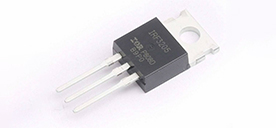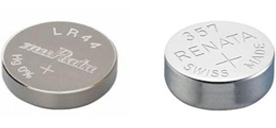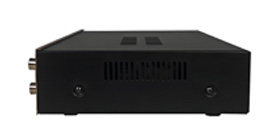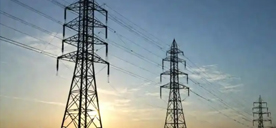Tesla 4680 Battery Charge to 100: Innovations and Performance
2024/6/24 15:45:22
Views:
This article delves into Tesla's newly launched 4680 battery, offering an in-depth analysis of its unique structural design, significant performance characteristics, and advanced manufacturing processes.
For Nanolongrange, 21700 vs. 18650
Introduction
1. Clarification
Tesla has developed a cutting-edge lithium-ion battery, labeled the 4680, which is uniquely designed for electric vehicles. The name '4680' derives from its physical measurements: it stands 80 millimeters tall and spans 46 millimeters in diameter.
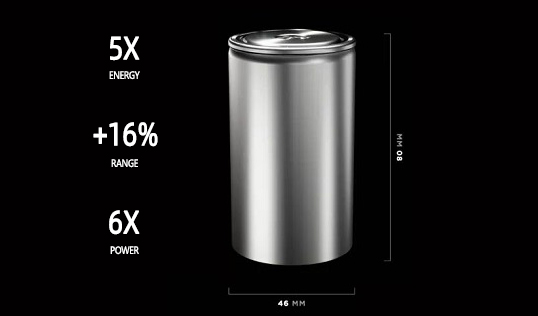
4680 battery indicator
This battery is distinguished by its superior energy capacity, enhanced charging capabilities, and extended durability.
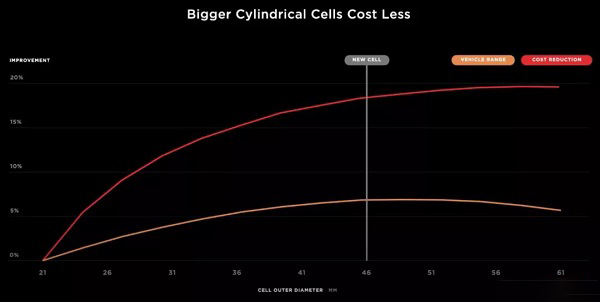
Changes in cylindrical battery size and performance
2. Core Innovations
The large-capacity battery combines tabless technology and dry battery technology. The core innovations include its structural design and the materials used, particularly the label-free design and improved battery chemistry. These design optimizations enhance internal energy flow and reduce complexity in manufacturing.
3. Performance Breakthroughs
With improved structure and chemical formulation, the 4680 battery significantly enhances power output (six times that of the 2170 battery) and reduces cost (only 14% of the 2170 battery), optimizes thermal management, production efficiency, charging speed, energy density, and relay performance. These improvements offer higher driving range, better sustained energy output, and stability, especially under extreme temperature conditions.
Structural Changes
● Tabless Design
The 4680 battery uses an improved TAB structure, significantly boosting power and optimizing heat dissipation, production efficiency, and charging speed.1. Tableless Structure
The battery enhances performance through a tabless ear design and continuous winding improvements. The direct connection of positive and negative terminals not only increases the current path but also reduces the distance between tabs, effectively boosting output power. Traditional flat plates and spacers are replaced with a new continuous winding method, reducing material usage and optimizing internal space. These structural optimizations not only lower internal resistance but also improve energy density, significantly enhancing energy output and efficiency.2. Advantages of Tables
- Increased Output Power: The 4680 battery features wide current channels and significantly reduced internal resistance, minimizing internal energy loss and greatly enhancing power output, performing six times better than the 2170 battery.- Improved Safety: Unlike traditional flat batteries, the cylindrical 4680 battery dissipates heat axially, mainly from the enlarged tab areas. This design provides broader thermal pathways compared to the narrow channels of the 2170 battery, reducing the traditional cylindrical battery's heat burden by 20% and significantly enhancing thermal stability and safety.
- Rapid Charge and Discharge Capabilities: By removing the anode structure, electrons move more freely within the battery, enhancing the current magnification effect and enabling faster charging and discharging, substantially shortening charging times.
- Increased Production Efficiency: The new 4680 battery eliminates steps such as adding tabs during production, saving production line space and reducing the likelihood of defects, thus enhancing overall manufacturing efficiency and cost-effectiveness.
● Large Battery
1. Performance
The 4680 battery features significant design improvements with a diameter expanded from 27 millimeters to 46 millimeters and height from 70 millimeters to 80 millimeters. This size increase results in a thicker battery body, reduced curvature, and an expanded hollow area, optimizing its structure and performance. This allows for more energy storage in the same external dimensions, thereby improving endurance.2. Advantages
- Cost Efficiency: By reducing the proportion of casing per unit capacity and simplifying structural components and weld points, the 4680 battery achieves significant cost reductions (14% lower than the 2170 battery).- Optimized Energy Density: As the battery size increases, the number of single cells within the battery pack decreases, reducing the proportion of metal casing while increasing the proportion of positive and negative electrode materials, effectively enhancing the battery's energy density.
- Enhanced BMS System Efficiency: With fewer cells in the battery pack, monitoring and status analysis become more straightforward, making the Battery Management System (BMS) more efficient and less burdensome.
- Integrated Structure and Function: Combining CTC technology, the 4680 battery not only features larger size and improved structural strength but is also directly integrated into the vehicle, enhancing overall structural stability. As part of the structural battery, it not only saves space but also helps reduce the vehicle's overall weight by about 10%, thereby increasing the driving range by 14%.
3. Disadvantages
- Increased Thermal Management Challenges: As the battery size increases, so does the heat generated, making heat dissipation more challenging and increasing the difficulty of thermal management. Tesla addresses this challenge with tabless technology, effectively enhancing the battery's thermal stability and achieving a significant breakthrough in heat dissipation performance.4. Real-World Performance
The 4680 battery's larger size allows for a considerable gain in energy density by reducing the number of units built in the battery pack and the fraction of metal case while increasing the proportion of positive and negative electrode materials. These structural adjustments increase the 4680 battery's energy capacity five times compared to the 2170 battery. Real-world tests also show that this battery maintains lower temperatures during fast charging, reducing energy loss and significantly prolonging its lifespan. The battery's driving range has increased by 16%, with 14% of this improvement attributed to the application of CTC technology. As battery material technology continues to evolve, energy density and performance are expected to further improve.
Dry Battery Technology
Dry electrode technology can be applied to both the positive and negative electrodes of the battery.1. Traditional Wet Process: Materials are soaked in a solution, then dried and pressed into films. This process involves using a solvent containing a binder, with NMP (N-Methyl-2-pyrrolidone) as a common choice. The binder-infused solvent combines with anode or cathode powder to form a paste, which is coated on the electrode collector and then dried. Due to the toxicity of the solvent, it needs to be recovered and purified for reuse, a step that requires large and expensive equipment for electrode coating.
2. Dry Battery Technology: The dry electrode process entirely eliminates the step of adding a solution, significantly simplifying the production process. First, polytetrafluoroethylene (PTFE) is combined with active positive and negative electrode particles, and then fibrillation is applied. Next, the powder is directly pressed, ground into a thin film, and then bonded to a metal foil, such as aluminum or copper foil, completing the preparation of positive and negative electrode sheets.
3. Advantages of Dry Batteries:
- Simplified Process: The process is simplified, thus saving costs, without the need for expensive coating machinery.
- Increased Production Speed: Dry electrode technology increases production speed to seven times the original rate.
- Enhanced Energy Density: In traditional methods, using solvents causes poor carbon bonding with lithium and lithium metal, leading to capacity loss during the first charging cycle. Dry battery technology effectively addresses this issue and, by increasing the thickness of the positive electrode material from 55μm to 60μm, improves the proportion of active electrode materials, ensuring power density while enhancing energy density by about 5%.
Silicon Anode
● Advantages
1. High Energy Density: Compared to the theoretical maximum capacity of 372Wh/kg for graphite anodes, silicon anodes can reach up to 4200Wh/kg.2. Enhanced Safety: Silicon has a higher voltage platform than graphite. Currently, lithium dendrites that might form in anodes using graphite, due to their voltage platform being close to the lithium plating potential, can penetrate the separator and cause a short circuit between the anode and cathode, greatly threatening battery safety.
3. Cost Advantage: Silicon is widely available, has abundant reserves, and is low in production cost and environmentally friendly. Silicon anode lithium-ion batteries can lower the cost per kilowatt-hour by at least 3% while increasing the mass and volumetric energy densities by more than 8% and 10%, respectively.
● Disadvantages
1. Weaker Cycling Capability: Compared to graphite electrodes, silicon electrodes undergo more than four times the volume expansion during lithium ion permeation, which ultimately leads to battery failure.2. Low Conductivity: Silicon's insufficient conductivity limits the full potential of its capacity and the high-rate performance of electrode materials. Volume changes upon contact with conductive agents and binders lead to decreased conductivity, and the thick and unevenly distributed SEI film formed on the silicon surface further weakens conductivity and overall battery energy ratio.
● Innovative Design: 4680 Battery
Tesla has innovatively designed the 4680 battery, selecting highly elastic materials and incorporating an elastic ion polymer coating to stabilize the silicon surface structure and further reduce costs by 5%.
![]()
The principle of negative process for Tesla silicon
● Prospects for Silicon Carbon Anode Materials
Major power battery producers, including Lishen Battery, CATL, Guoxuan High-Tech, and Pulead, are concentrating on silicon carbon anodes as a critical area of future research. Silicon carbon anodes are now mostly employed in cylindrical batteries. As high-energy-density batteries, silicon carbon batteries are expected to overcome technical barriers gradually and gain widespread acceptance among consumers. By 2023, the production and consumption of silicon carbon anode materials are expected to reach 60,000 tons, demonstrating significant market potential.
Cathode
Tesla's battery strategy showcases diversity, with various vehicle models employing different electrode material configurations. The 4680 lithium iron battery is primarily used in low-range vehicle models and energy-saving batteries, characterized by numerous cycles. The 4680 lithium nickel manganese battery is widely used in mid-range electric vehicle models and home battery markets, while the high nickel version of the 4680 battery is specifically designed for models like the Cybertruck and Semi.
In the development of positive electrode materials, Tesla mainly pursues high nickel and cobalt-free solutions to enhance battery performance and safety. Although
no groundbreaking innovation direction has been proposed, Tesla still adopts the NCA single-crystal material path, increasing energy density by raising the voltage, a method that makes the material's thermal stability comparable to that of lithium iron phosphate.
● Diverse Development of 4680 Battery Cathode Materials
The 4680 battery currently covers three main types of cathode materials: high nickel, lithium nickel manganese, and lithium iron.1. High Nickel is Core to the 4680 Battery
Currently, Tesla's research and development focus on the high nickel version of the 4680 battery. This technology will be widely used in future high-performance models like the Cybertruck, Semi, Model 3, and Model Y.
2. Nickel Manganese Version of the 4680 Battery: A follow-up
As the technology for the high nickel version matures, Tesla plans to further develop the nickel manganese version of the 4680 battery. This new battery will be promoted for use in mid-range electric vehicle models like the Model Y and in the home battery market.
3. Development of Lithium Iron Cathode Version
Although Tesla did not specify the cycle performance of the 4680 battery during its release, it is clear that the volume expansion of the silicon-based anode affects its charging and discharging performance. The launch of the lithium iron cathode version of the 4680 battery is also scheduled, with an emphasis on excellent cycle performance and projected application in low-cost models and energy-saving batteries, as the technology for the nickel manganese version of the battery advances.
In summary, the diverse development of 4680 battery cathode materials will significantly enhance its performance and market competitiveness, continually emerging to meet the needs of different vehicle models and demands.
Conclusion
The integration of large battery technology, tabless electrodes, and dry battery processes forms the core innovation framework of the 4680 battery. This battery technology not only enhances energy efficiency and production efficiency but also significantly boosts battery safety and fast charging capabilities. Although battery costs are effectively controlled, its energy density and cycling performance still require further optimization. The main challenges currently hindering this technology's development include the precise production of full tabs, complex welding processes, and the fine craftsmanship of dry electrodes. The 4680 battery was initially used in high-nickel systems, and Tesla and Panasonic plan to begin large-scale manufacture of the battery in the first half of 2022.Demand for carbon nanotube conductive agents, big cylindrical structural components, high-nickel cathodes, and new lithium salts is expected to increase as a result of this action.
Appendix
1. Global Impact and Sustainability Efforts- Discuss how Tesla's advancements in battery technology contribute to global efforts in reducing carbon emissions and dependence on fossil fuels.
- Explore the potential environmental impacts of increased lithium mining required for these batteries, including strategies for sustainable sourcing and recycling of battery materials.
2. Comparative Analysis with Competitors
- Include a comparison of Tesla's 4680 battery with other leading technologies in the market, such as those from BYD, LG Chem, and Samsung.- Highlight what makes Tesla's battery unique in terms of performance, cost, and scalability compared to these competitors.
3. Regulatory and Safety Standards
- Address the regulatory challenges and safety standards associated with the mass production and use of high-capacity lithium-ion batteries.- Explore Tesla's compliance strategies and any innovative approaches to meeting these regulations.
4. Economic Impact
- Discuss the economic implications of adopting Tesla's 4680 battery technology on a large scale, including potential job creation in manufacturing and R&D.- Analyze the impact on the cost of electric vehicles and the broader implications for consumer adoption rates.
5. Technological Challenges and Future Research
- Delve deeper into the specific technological hurdles that Tesla faces in scaling up the production of the 4680 batteries.- Highlight ongoing research areas, such as improving the lifecycle of the battery and enhancing the energy density beyond current capabilities.
6. Market Penetration and Consumer Reception
- Provide insights into how the market is reacting to Tesla's new battery technology, including potential adoption rates and feedback from early users.- Discuss any partnerships or collaborations that Tesla might be engaging in to promote and distribute these batteries globally.
7. Future Roadmap and Technological Horizons
- Outline Tesla's future roadmap for its battery technology, including planned upgrades or next-generation developments.- Discuss emerging technologies that could potentially intersect or compete with Tesla's battery technology in the future.
Related Information
-
-
Phone
+86 135 3401 3447 -
Whatsapp

